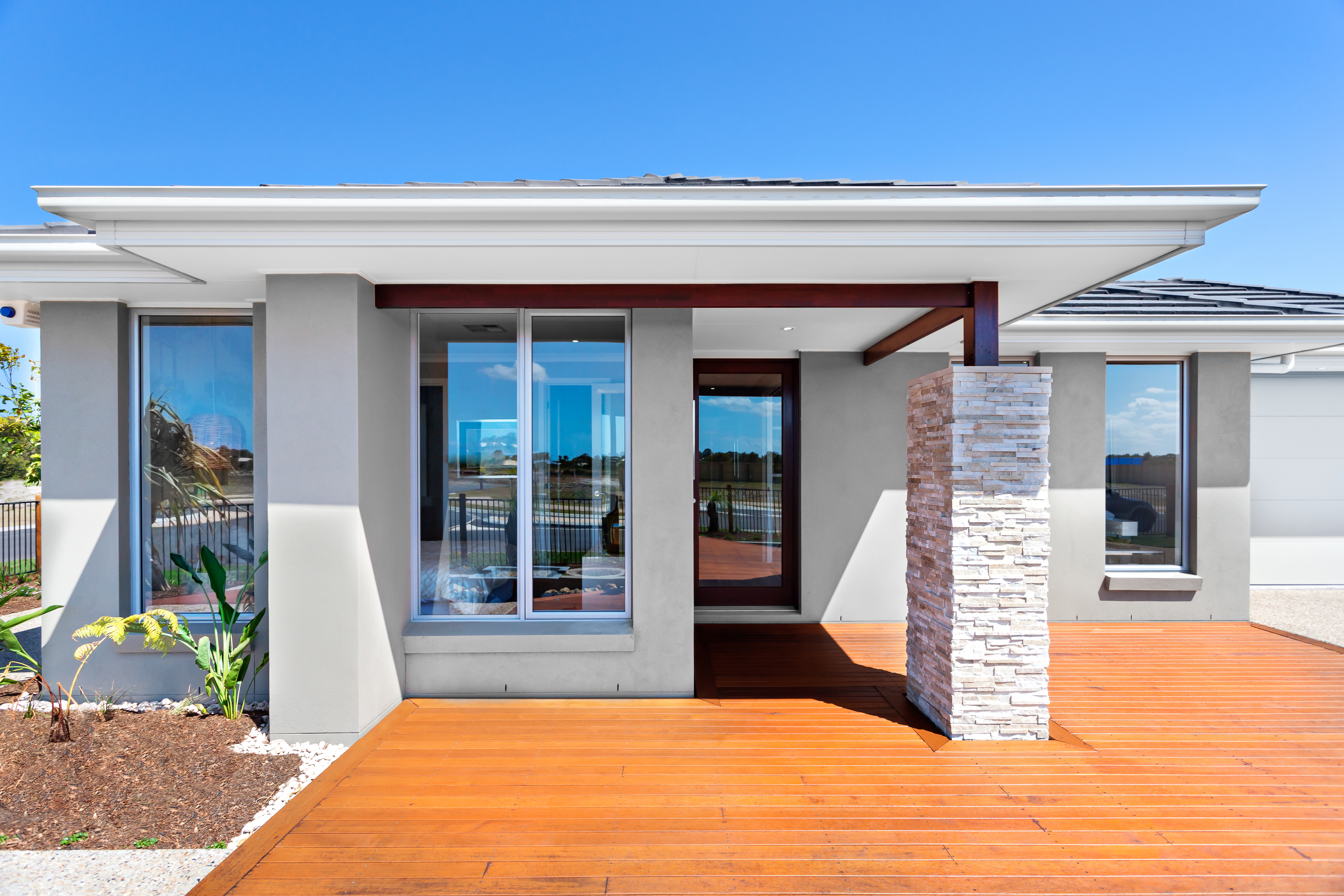Read on to find out what cladding materials are used in the building industry and how well they act as protection.
What is Cladding?
Cladding is a non-loadbearing skin or layer attached to the outside of a home to shed water and protect the building from the effects of weather. Cladding material plays a vital role in the aesthetic appeal, the building cost and property value of the home. Controlling the infiltration of weather elements and water vapour while making a building’s exterior look more attractive is the main role of cladding. Secondary roles can include sound and thermal insulation, and fire resistance. The type of material used for cladding will influence the environmental performance of your home and should also be picked based on a careful assessment and prioritisation of each of the roles. To achieve the best results in physical performance and aesthetics, the choice of cladding material should be specific to elevation or exposure.
Cladding Materials
Brick
Brick is the most commonly used cladding system and has a very high embodied energy level. Brick cladding requires low maintenance if unpainted but if rendered, the maintenance if quite high. There is a diverse range of colours and finishes available. Brick is highly durable on well-designed footings and less suited to seismic loads and reactive soils. It has high breathability with very low condensation risk when breathable sarking is used, due to well ventilated and high cavity. Brick cladding has a low waterproof level and requires wide cavity and specially designed ties, flashings and cavity drainage. It works as a poor insulator but is extremely fire resistant and non-toxic. However, paints and sealants can have toxicity issues. Brick cladding is great for recycling and reuse as they can be recycled into new brick or crushed for fill. The use of high strength mortar prevents reuse, but bricks laid with low strength mortar are often cleaned and reused.
Reconstituted Timber Products
Many reconstituted timber products are made from forestry waste and are among the most sustainable of all cladding options. This type of cladding material is made with minimal energy or chemical input, high manufacturing waste recovery and water recycling. Reconstituted timber products are available in most locations and are among the lowest embodied energy cladding materials currently Available in Australia. Its maintenance level is considered moderate, requiring painting and is available in a diverse range of patterns, shapes and finishes. Surface and dimensional stability will reduce the amount of maintenance again. Timber cladding is highly durable and has good breathability (depending on the finish) with low condensation risk. Breathable sarking with a condensation cavity is strongly recommended in condensation prone climates. It has a high level of water and fire resistance. Natural timber resins are used to bond particles under high temperature and pressure, so therefore is non-toxic. When paints and sealants are used, toxicity issues arise of course. Reconstituted timber is generally not recycled due to its finishes. However, limited reuse is possible but often not implemented as new material is low in cost.
Fibre Cement
Fibre cement is manufactured in a strict factory-controlled environment and has high sustainability credentials. It is typically produced as planks, weatherboards or sheets. Sheet products are generally thinner and therefore less material intensive but often have higher site waste rates — particularly on complex designs and shapes. It is commonly available due to its high level of transportability. Fibre cement has a generally low level of embodied energy but can vary with volumes, cement content and manufacturing efficiency. It requires low maintenance due to its stability but requires painting to maintain waterproofness. Stamped or sawn patterns can also be applied during the manufacturing process to create an aesthetic appeal. Some applications in sheltered locations require one-off staining. Fibre cement is highly durable and dimensionally stable and is suitable for sites subject to seismic or geotechnical movement. Its breathability is quite good (depending on the finish) with very low condensation risk but can be subject to surface mould growth if exposed to regular condensation. Breathable sarking with a condensation cavity is strongly recommended in high risk climates. Fibre Cement cladding is highly waterproof but varies according to thickness and finish. It works as a poor insulator but has a high level of fire resistance and is non toxic. There is also a diverse range of patterns, shapes and finishes available as finishes for fibre cement. In regards to the depletion of this resource, fibre is renewable. However, cement is a finite resource and non-renewable, and sand and fines are abundant but also non-renewable. Fibre cement is generally not recycled due to its finishes.
Timber Weatherboards
Timber weatherboards (vertical and horizontal) are available in a wide range of products and profiles. Maintenance is high as timber is subject to shrinkage, swelling, cracking and rot unless sealed well. Its embodied energy is among the lowest of all cladding materials and ranges from low to very low depending on the manufacturing process, preservatives and termite treatment. Timber weatherboards have low to moderate durability depending on maintenance but can also vary in durability grading due to sapwood (prone to rot) and heartwood (more durable) content and exposure during milling. Breathability is high but can be decreased with paints and finishes. Joint detailing generally allows enough breathing to prevent condensation, but breathable sarking is essential and vapour cavities are important in climates with a higher condensation risk. Timber weatherboards are generally quite waterproof but depend largely on the profile and stability of the boards. Horizontal weatherboard systems are more waterproof in rain exposed locations. Its insulation varies with its thickness, sealing and density. With an exception of a few hardwood species, timber weatherboards have poor fire resistance. This material is non-toxic if untreated but like all other cladding systems, paints and sealants can have toxicity issues. Timber is generally painted, oiled or stained as a finish and requires regular treatment due to natural movement and deterioration. This source is renewable when plantation is grown but when sourced from old growth forests, contributes to high value biodiversity loss and the depletion of non-renewable resources. It is also difficult to reuse timber weatherboards due to the fixings and the additional joins required as its lengths decrease with each use. You can recycle this material by chipping for mulch but is not possible for painted or treated products.
Plywood Sheeting
Plywood sheeting is available throughout Australia and is generally painted, oiled or stained once finished. It has low to moderate embodied energy, but its manufacturing process and glues make its embodied energy higher than natural timber. Depending on the grade of plywood, maintenance levels are moderate to low. Its durability levels are moderate to very high depending on the grade, species, glues and maintenance of the plywood. Low grade ply requires similar protection to timber. While expensive, marine grade ply is among the most durable finishes available for corrosive environments (e.g. waterfront) but can contain toxic glues and preservatives. Its breathability is generally low but varies with the thickness and grade of plywood. Depending on its finish and joint detailing, plywood sheeting is highly waterproof. It also has limited insulation and not a lot of fire resistance. Plywood is renewable when plantation is grown and is highly reusable, but cannot be recycled.
Steel
Steel cladding is available in all regions of Australia and comes in a wide variety of cold formed profiles with varying base metal gauge and structural capacity. There are a range of standard colours and finishes available including galvanised and zinc/aluminium corrosion treatments and a range of standard baked enamel pre-finish colours. With a high level of embodied energy and very low maintenance, steel finishes are very durable and, while coloured finishes often fade, they rarely require repainting for maintenance. Galvanised corrugated steel can actually last more than 100 years on a building and is highly sought after for its decorative use. However, fixings and flashings must be compatible for corrosion and life span and must be installed carefully. Scratches and lead pencil marks from cutting can lead to early corrosion. Steel cladding has excellent conductivity, making it highly susceptible to dew-point formation and water vapour condensation. It should always be fixed via a breathable cavity. This material is amongst the most waterproof of all cladding materials, but has zero insulation. It is highly fire resistant as both a roof and wall cladding and is also non toxic. Steel is a non-renewable source, but steel sheeting is highly reusable and 100% recyclable.
Aluminium
Aluminium cladding is available in all regions of Australia and has a similar range of profiles to steel. Like Steel, aluminium cladding comes in a wide variety of cold formed profiles with varying base metal gauge and structural capacity. It is more corrosion resistant than steel and has the highest embodied energy of any cladding system. Aluminium cladding has generally low maintenance. Powder coated finishes have a life expectancy of 15 years and rarely requires repainting for protection even when faded. It is highly durable due to its corrosion resistance and among the most waterproof of all cladding materials. Aluminium also has zero insulation, is fairly fire resistant and non-toxic. This cladding material is an abundant but non-renewable resource. It is highly reusable (if screw fixed) and 100% recyclable.
Information Source: http://www.yourhome.gov.au/sites/prod.yourhome.gov.au/files/pdf/YOURHOME-Materials-CladdingSystems.pdf





